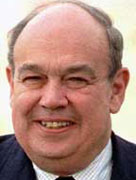Charles Kuralt

CBS News correspondent
Charles Kuralt was born in Wilmington, North Carolina, and moved with his family up and down the state before they settled in Charlotte, North Carolina. His passion for reporting asserted itself early, and he worked for several local newspapers and a radio station while still in high school. At the University of North Carolina in Chapel Hill, he edited the student-owned newspaper, The Daily Tar Heel. After his year as editor, he left the University without taking a degree and returned to Charlotte to become general assignment reporter for the Charlotte News. Within a few months, he began to write a daily column, People, describing the lives of everyday citizens, a taste of things to come. His work at the News won the Ernie Pyle prize and attracted attention outside of North Carolina.
In 1957, still only months out of school, he was offered a job at CBS News. He was to remain with CBS for the rest of his life. His first assignment was writing the five-minute radio broadcasts that aired hourly between two and six AM. He began work each day at midnight, and worked until eight in the morning, but he was thrilled to be working in the same building as his hero, Edward R. Murrow. After a single week of substituting for a vacationing writer on Murrow's nightly broadcast, Kuralt was transferred to the fledgling television news department, as a writer for the CBS Evening News.
Although the writer's job was considered a plum position for a novice like Kuralt, he was eager to be a reporter, out in the field. He willingly took a cut in pay and returned to the graveyard shift, but this time as a "reporter contact" on the assignment desk, where he might have the opportunity to cover breaking news. Within the year CBS offered him the job of his dreams. He was 23, and now had the title of CBS News Correspondent, just like his idols, Murrow and Sevareid.
He traveled everywhere, covering political conventions, presidential campaigns, wars in the Congo, Laos and Vietnam, school integration in the South and piracy on the high seas. In 1960, he was the first host of the prime time TV series Eyewitness. As Chief Latin American Correspondent he visited all 23 nations of the region. In 1963 he served as Chief West Coast Correspondent for CBS and then returned to the New York bureau.
In October, 1967, he began to travel the back roads of America, producing his famous "On the Road" segment for the CBS Evening News. Over the next 20 years, Kuralt and his crew visited every state of the Union in their battered motor home, logging more than a million miles. He did stories on "wrestlers and jugglers and mountain climbers, traffic cops, tattoo artists, gandy dancers, sheep shearers, bagel bakers, horseshoe players, rodeo riders, sorghum makers and seashell collectors." Kuralt's discoveries included a 104 year-old jogger, a man who lived in a house made of beer bottles, and the owner of the world's largest ball of string.
Besides appearing on the evening network news, his adventures provided material for a series of best-selling books, On the Road with Charles Kuralt and Dateline: America. His other books include To the Top of the World (an account of a trip to the Arctic), North Carolina Is My Home, and his best-selling autobiography, A Life on the Road.
Into the 1980s, Charles Kuralt continued to report from the road, while flying back to New York each weekend to anchor the CBS Sunday Morning show. During the Persian Gulf crisis, he co-anchored the nightly CBS News broadcast America Tonight. Over the course of his career, he won three Peabody awards and ten Emmy Awards for his broadcast journalism. Charles Kuralt died in New York City at the age of 62.
The newsman's death brought the unexpected revelation of an unusually complicated private life. For nearly 30 years, Kuralt had maintained one home with his wife in Manhattan, and another with his lover -- and her children by a previous marriage -- in San Francisco. Before his death, he transferred ownership of a mountain home in Montana to his lover, Patricia Shannon, but his family made claim to the adjoining property. Kuralt's lawful wife died before the final disposition of the case, and Mrs. Shannon succeeded in documenting, to the court's satisfaction, Kuralt's intent to leave her the entire property. The case provided a challenging study for scholars of probate and family law, and a poignant footnote to the life of an admired public figure.